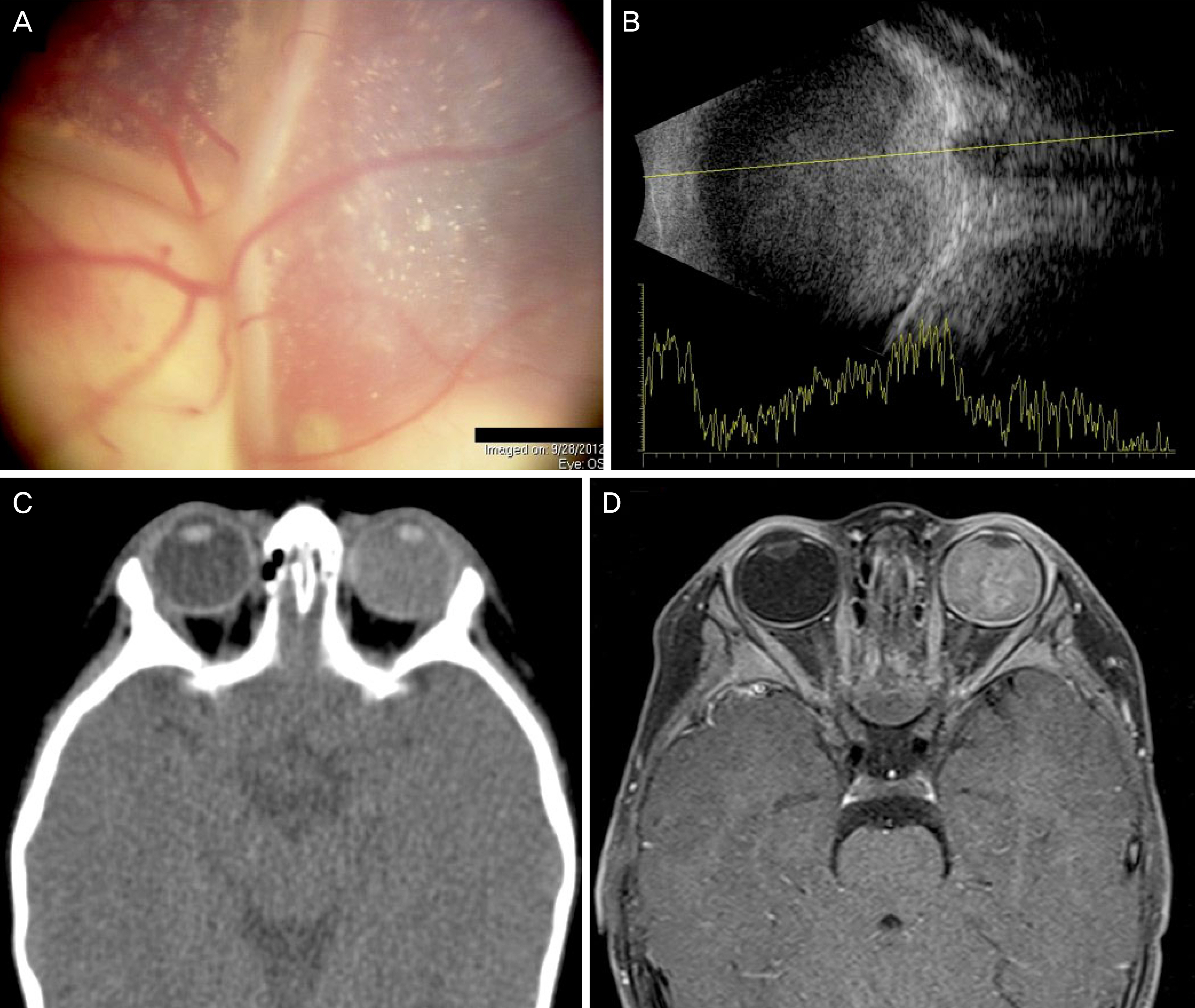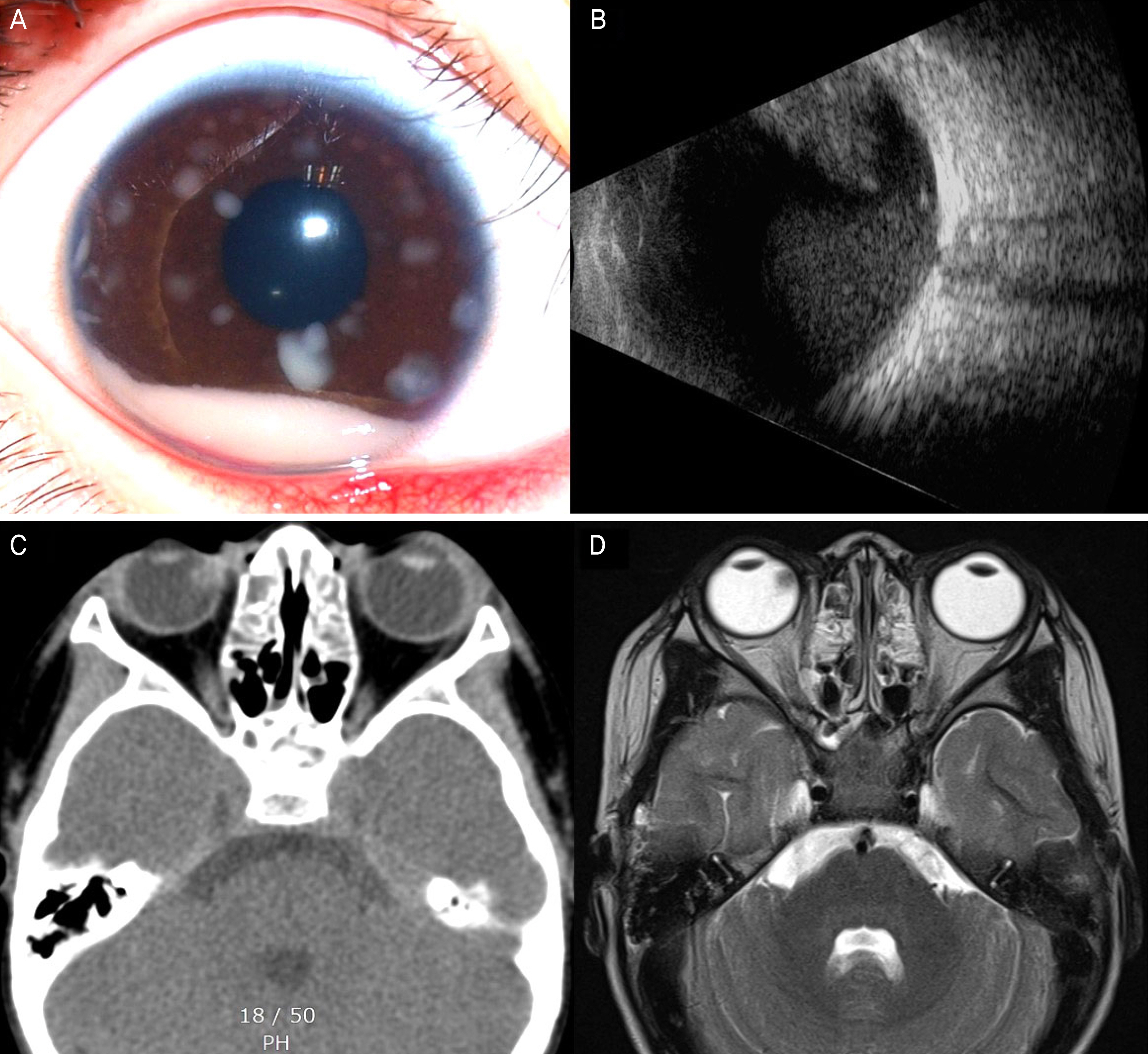J Korean Ophthalmol Soc.
2016 May;57(5):829-836. 10.3341/jkos.2016.57.5.829.
Clinical Characteristics of Retinoblastoma Patients whose Diagnosis was Difficult due to Atypical Ocular Manifestation
- Affiliations
-
- 1Department of Ophthalmology, Seoul National University College of Medicine, Seoul, Korea. ysyu@snu.ac.kr
- 2Department of Biomedical Sciences, Seoul National University College of Medicine, Seoul, Korea.
- 3Fight against Angiogenesis-Related Blindness Laboratory, Biomedical Research Institute, Seoul National University Hospital, Seoul, Korea.
- KMID: 2212728
- DOI: http://doi.org/10.3341/jkos.2016.57.5.829
Abstract
- PURPOSE
To report the clinical characteristics of retinoblastoma patients whose diagnosis was difficult due to atypical ocular manifestations.
METHODS
Among retinoblastoma patients who were diagnosed and treated from January 1999 to December 2014 at Seoul National University Children's Hospital, 6 patients whose diagnosis was difficult were retrospectively reviewed. Factors including age, sex, family history, initial findings, time to final diagnosis, histopathologic examination, additional treatment, and survival rate were evaluated.
RESULTS
Among 6 patients, 5 were male, and the mean age at the initial visit was 32.9 ± 19.1 months. None of the patients had family history, and all presented with unilateral lesion at the initial visit. The initial diagnoses were Coats' disease and uveitis in 2 patients, respectively, and persistent hyperplastic primary vitreous and traumatic hyphema in 1 patient, respectively. During an intensive short-term follow-up of 8.3 ± 5.3 weeks, 2 patients showed malignant cells after external subretinal fluid drainage procedure, and 4 patients demonstrated increasing ocular size or calcification in imaging. These patients received enucleation under suspicion of malignancy and were finally diagnosed with retinoblastoma after histopathologic examination. There were 2 patients with optic nerve involvement, and 3 patients underwent additional systemic chemotherapy. Five patients were followed-up for 7.6 ± 6.3 years after enucleation, and the mean age at final follow-up was 10.6 ± 7.4 years.
CONCLUSIONS
Retinoblastoma is one of the diseases in which early diagnosis and treatment are important. However, some cases are difficult to diagnose, even for experienced clinicians. If there are no typical manifestations such as mass or calcification and early findings show retinal detachment, glaucoma, pseudohypopyon, or hyphema, intensive short-term follow-up to exclude retinoblastoma is needed.
Keyword
MeSH Terms
Figure
Reference
-
References
1. Ellsworth RM. The practical management of retinoblastoma. Trans Am Ophthalmol Soc. 1969; 67:462–534.2. Seregard S. Lundell G. Svedberg H. Kivelä T. Incidence of retinoblastoma from 1958 to 1998 in Northern Europe: advantages of birth cohort analysis. Ophthalmology. 2004; 111:1228–32.3. Broaddus E. Topham A. Singh AD. Incidence of retinoblastoma in the USA: 1975-2004. Br J Ophthalmol. 2009; 93:21–3.
Article4. Binder PS. Unusual manifestations of retinoblastoma. Am J Ophthalmol. 1974; 77:674–9.
Article5. Haider S. Qureshi W. Ali A. Leukocoria in children. J Pediatr Ophthalmol Strabismus. 2008; 45:179–80.
Article6. Stafford WR. Yanoff M. Parnell BL. Retinoblastomas initially misdiagnosed as primary ocular inflammations. Arch Ophthalmol. 1969; 82:771–3.
Article7. Shields JA. Shields CL. Differentiation of coats’ disease and retinoblastoma. J Pediatr Ophthalmol Strabismus. 2001; 38:262–6. quiz. 302–3.
Article8. Shields JA. Shields CL. Parsons HM. Differential diagnosis of retinoblastoma. Retina. 1991; 11:232–43.
Article9. Rodrigues KE. Latorre Mdo R. de Camargo B. Delayed diagnosisin retinoblastoma. J Pediatr (Rio J). 2004; 80:511–6.10. Kim JH. Yu YS. Incidence (1991~1993) and survival rates (1991-2003) of retinoblastoma in Korea. J Korean Ophthalmol Soc. 2010; 51:542–51.
Article11. Patelli F. Zumbo G. Fasolino G, et al. Treatment and outcome of exudative retinal detachment in Coats disease: a case report. Semin Ophthalmol. 2004; 19:117–8.
Article12. Kincaid MC. Ocular and orbital tumors. Ophthalmology. 1988; 95:1588–95.
Article13. Reese AB. Telangiectasis of the retina and Coats’ disease. Am J Ophthalmol. 1956; 42:1–8.
Article14. Choi SY. Yu YS. Treatment and clinical results of Coats’ disease. J Korean Ophthalmol Soc. 1999; 40:2190–7.15. Shields JA. Shields CL. Honavar SG, et al. Classification and management of Coats disease: the 2000 Proctor Lecture. Am J Ophthalmol. 2001; 131:572–83.
Article16. Ma DJ. Choi J. Jang JW, et al. Bilateral Coats’ disease: a case report. J Korean Ophthalmol Soc. 2011; 52:112–6.
Article17. Miller DM. Benz MS. Murray TG. Dubovy SR. Intraretinal calcification and osseous metaplasia in coats disease. Arch Ophthalmol. 2004; 122:1710–2.
Article18. Lam HD. Samuel MA. Rao NA. Murphree AL. Retinoblastoma presenting as Coats’ disease. Eye (Lond). 2008; 22:1196–7.
Article19. Shields CL. Uysal Y. Benevides R, et al. Retinoblastoma in an eye with features of Coats’ disease. J Pediatr Ophthalmol Strabismus. 2006; 43:313–5.
Article20. Jack RL. Regression of the hyaloid vascular system. An ultrastructural analysis. Am J Ophthalmol. 1972; 74:261–72.21. Kyung HS. Yu YS. Clinical findings and prognosis of persistent hyperplastic primary vitreous. J Korean Ophthalmol Soc. 2004; 45:1528–34.22. Català-Mora J. Parareda-Salles A. Vicuña-Muñoz CG, et al. Uveitis masquerade syndrome as a presenting form of diffuse retinoblastoma. Arch Soc Esp Oftalmol. 2009; 84:477–80.23. Balmer A. Zografos L. Munier F. Diagnosis and current management of retinoblastoma. Oncogene. 2006; 25:5341–9.
Article
- Full Text Links
- Actions
-
Cited
- CITED
-
- Close
- Share
- Similar articles
-
- Ocular Protrusion and Spontaneous Regression in Bilateral Retinoblastomas
- Clinical Characteristics of the Retinoblastoma Diagnosed before One Year Old
- Clinical Features and Long-term Prognosis of Retinoblastoma according to Age at Diagnosis
- Three Cases of Trilateral Retinoblastoma
- A Case of Retinoblastoma and Coats' Disease in the Same eye: A Clinicopathologic Report





